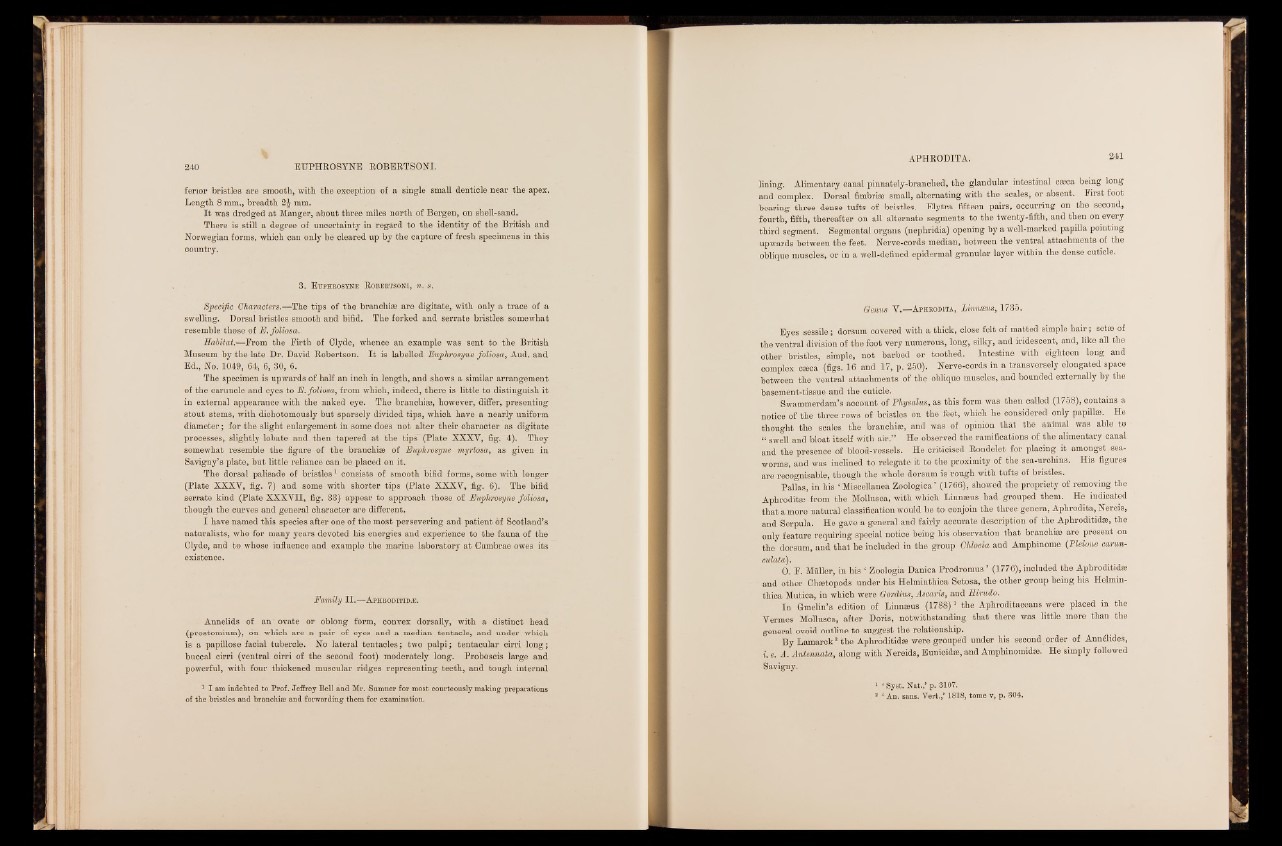
240 EUPHROSYNE ROBERTSONI.
ferior bristles are smooth, with the exception of a single small denticle near the apex.
Length 8 mm., breadth 2^ mm.
I t was dredged at Manger, about three miles north of Bergen, on shell-sand.
There is still a degree of uncertainty in regard to the identity of the British and
Norwegian forms, which can only be cleared up by the capture of fresh specimens in this
Country.
3. E uphrosyne Robertsoni, n. s.
Specific Characters.—The tips of the branchias are digitate, with only a trace of a
swelling. Dorsal bristles smooth and bifid. The forked and serrate bristles somewhat
resemble those of E. foliosa.
Habitat.—From the Firth of Clyde, whence an example was sent to the British
Museum by the late Dr. David Robertson. I t is labelled Euphrosyne foliosa, Aud. and
Ed., No. 1049, 64, 6, 30, 6.
The specimen is upwards of half an inch in length, and shows a similar arrangement
of the caruncle and eyes to E. foliosa, from which, indeed, there is little to distinguish it
in external appearance with the naked eye. The branchiae, however, differ, presenting
stout stems, with dichotomously but sparsely divided tips, which have a nearly uniform
diameter; for the slight enlargement in some does not alter their character as digitate
processes, slightly lobate and then tapered at the tips (Plate XXXY, fig. 4). They
somewhat resemble the figure of the branchiae of Euphrosyne myrtosa, as given in
Savigny’s plate, but little reliance can be placed on it.
The dorsal palisade of bristles1 consists of smooth bifid forms, some with longer
(Plate XXXY, fig. 7) and some with shorter tips (Plate XXXY, fig. 6). The bifid
serrate kind (Plate XXXVII, fig. 33) appear to approach those of Euphrosyne foliosa,
though the curves and general character are different.
I have named this species after one of the most persevering and patient of Scotland’s
naturalists, who for many years devoted his energies and experience to the fauna of the
Clyde, and to whose influence and example the marine laboratory at Cumbrae owes its
existence.
Family II.—Aphroditid.®.
Annelids of an - ovate or oblong form, convex dorsally, with a distinct head
(prostomium), on which are a pair of eyes and a median tentacle, and under which
is a papillose facial tubercle. No lateral tentacles; two palpi; tentacular cirri long;
buccal cirri (ventral cirri of the second foot) moderately long. Proboscis large and
powerful, with four thickened muscular ridges representing teeth, and tough internal
1 I am indebted to Prof. Jeffrey Bell and Mr. Sumner for most courteously making preparations
of the bristles and branchiae and forwarding them for examination.
lining. Alimentary canal pinnately-branched, the glandular intestinal casca being long
and complex. Dorsal fimbriae small, alternating with the scales, or absent. First foot
bearing three dense tufts of bristles. Elytra fifteen pairs, occurring on the second,
fourth, fifth, thereafter on all alternate segments to the twenty-fifth, and then on every
third segment. Segmental organs (nephridia) opening by a well-marked papilla pointing
upwards between the feet. Nerve-cords median, between the ventral attachments of the
oblique muscles, or in a well-defined epidermal granular layer within the dense cuticle.
Genus Y.—A p h r o d it a , Linnaeus, 1735.
Eyes sessile; dorsum covered with a thick, close felt of matted simple hair; setrn of
the ventral division of the foot very numerous, long, silky, and iridescent, and, like all the
other bristles, simple, not barbed or toothed. Intestine with eighteen long and
complex caeca (figs. 16 and 17, p. 250). Nerve-cords in a transversely elongated space
between the ventral attachments of the oblique muscles, and bounded externally by the
basement-tissue and the cuticle.
Swammerdam’s account of Physalms, as this form was then called (1758), contains a
notice of the three rows of bristles on the feet, which he considered only papillae. He
thought the scales the branchiae, and was of opinion that the animal was able to
“ swell and bloat itself with air.” He observed the ramifications of the alimentary canal
and the presenoe of blood-vessels. He criticised Eondelet for placing it amongst/Sea-
worms, and was inclined to relegate | | to the proximity of the sea-urchins. His figures
are recognisable, though the whole dorsum is'rough with tufts of bristles.
Pallas, in his ‘ Miscellanea Zoologies ’ (1766), showed the propriety of removing the
Aphrodite from the Mollusca, with which Linnaeus had grouped them. He indicated
that a more natural classification would be to conjoin the three genera, Aphrodita, Nereis,
and Serpula. He gave a general and fairly accurate description of the Aphroditid®, the
only feature requiring speoial notice being his observation that branchiae are present on
the dorsum, and that he included in the group Ghloeia and Amphinome (Pleione carun-
culata).
0. F. Müller, in his * Zoologia Danica Prodromus ’ (1776), included the Aphroditidm
and other Chsetopods under his Helminthica Setosa, the other group being his Helmin-
thica Mutica, in which were Gordius, Ascaris, and Hirudo.
In Gmelin’s edition of Linnaus (1788) 1 the Aphroditaceans were placed in the
Yermes Mollusca, after Doris, notwithstanding that there was little more than the
general ovoid outline to suggest the relationship.
By Lamarck3 the Aphroditidm were grouped under his second order of Annblides,
i. e. A. Antennata, along with Nereids, Eunicidae, and Amphinomidse. He simply followed
Savigny.
1 ‘ Syst. Nat.,’ p. 3107.
2 ‘An. sans. Vert.,’ 1818, tome v, p. 304.